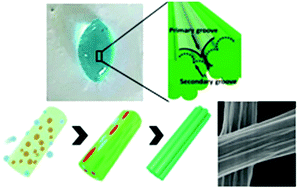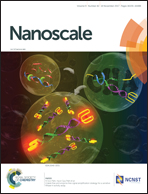Double-grooved nanofibre surfaces with enhanced anisotropic hydrophobicity†
Abstract
This study reports a facile method for fabricating double-grooved fibrous surfaces. The primary grooves of the surface are formed by aligned fibres, while the secondary grooves are achieved by oriented nanogrooves on the fibre surface. Investigation into the formation mechanism reveals that the nanogrooves can be readily tailored through adjusting the solvent ratio and relative humidity. With this understanding, a variety of polymers have been successfully electrospun into fibres having the same nanogrooved feature. These fibres show high resemblance to natural hierarchical structures, and thereby endowing the corresponding double-grooved surface with enhanced anisotropic hydrophobicity. A water droplet at a parallel direction to the grooves exhibits a much higher contact angle and a lower roll-off angle than the droplet at a perpendicular direction. The application potential of such anisotropic hydrophobicity has been demonstrated via a fog collection experiment, in which the double-grooved surface can harvest the largest amount of water. Moreover, the fabrication method requires neither post-treatment nor sophisticated equipment, making us anticipate that the double-grooved surface would be competitive in areas where a highly ordered surface, a large surface area and an anisotropic hydrophobicity are preferred.



 Please wait while we load your content...
Please wait while we load your content...